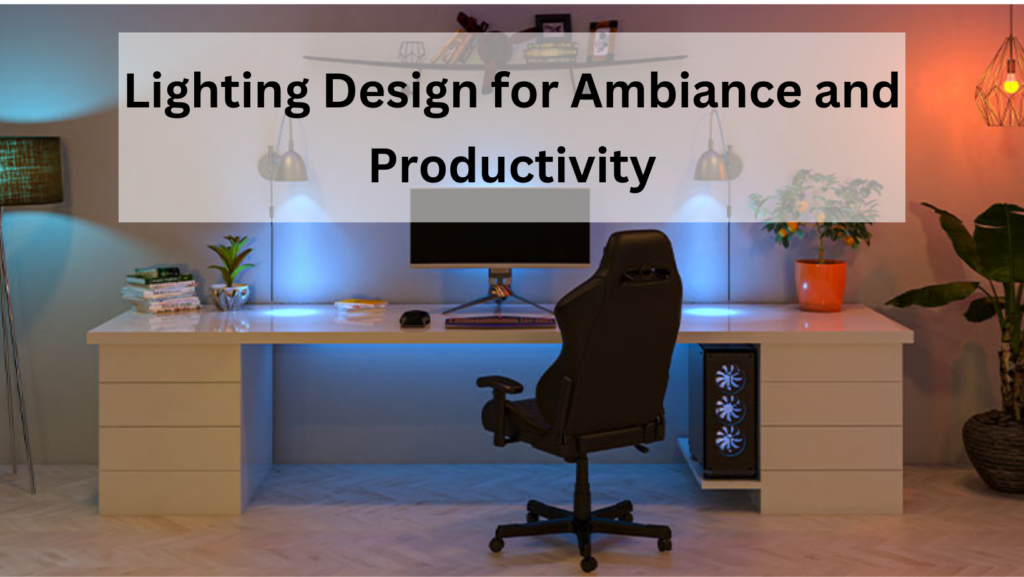Optimal Workspace Selection:
Begin by choosing the most suitable area for your home office. Ideally, this should be a quiet and well-lit space with minimal distractions. Consider factors like proximity to household activities and accessibility to natural light. Assess the available space to ensure it accommodates your furniture and equipment comfortably.
Begin by selecting a dedicated area for your home office. Consider factors like natural light, noise level, and proximity to household activities. Ideally, choose a space with minimal distractions to promote focus.

Ergonomic Furniture for Comfort and Productivity Home Office:
Invest in ergonomic furniture to create a comfortable and productive work environment. Your chair should support good posture and minimize the risk of discomfort or injury. Choose a desk with ample surface area for your computer, documents, and other work essentials.
Adjustable features such as chair height and desk height are crucial to customize the setup according to your body’s needs. Invest in a comfortable chair and an ergonomically designed desk. Your chair should support good posture, and the desk should have enough surface area for your computer, documents, and other essentials.
Consider adjustable features to customize the setup to your preferences. Maximize space efficiency by incorporating dual-purpose furniture. Consider desks with built-in storage, foldable tables, or wall-mounted shelves. This approach optimizes your home office layout, especially if the space is limited.
Choose furniture that serves multiple functions, allowing you to adapt the setup based on your current work requirements and providing versatility in a compact environment.

Lighting Design for Ambiance and Productivity:
Proper lighting is essential for creating a conducive work environment. Position your desk near a window to take advantage of natural light. Additionally, incorporate task lighting with adjustable brightness to reduce eye strain. Opt for LED bulbs that emit warm white light, creating a well-lit and inviting atmosphere in your home office.
Natural light is crucial for productivity and mood. Position your desk near a window, if possible. Additionally, use task lighting to reduce eye strain. Choose LED bulbs with warm white light to create a well-lit and inviting atmosphere. Prioritize energy-efficient lighting solutions to reduce electricity consumption.
Use LED bulbs, which not only save energy but also last longer. Incorporate sensors or smart lighting systems that automatically adjust brightness based on natural light levels. This sustainable approach not only lowers your environmental footprint but also contributes to cost savings in the long run.

Organizational Storage Solutions:
Efficient storage solutions are key to maintaining a clutter-free and organized workspace. Use shelves, drawers, and organizers to keep supplies, files, and equipment neatly arranged. Establish a filing system for paperwork and leverage digital tools for the virtual organization.
A well-organized space contributes to a more efficient workflow and reduces stress associated with clutter. Keep your space clutter-free with efficient storage solutions. Shelves, drawers, and organizers can help keep supplies, files, and equipment neatly arranged. Consider a filing system for paperwork and digital tools for virtual organization.

Technological Infrastructure for Seamless Operations:
A reliable and well-configured technological setup is crucial for a productive home office. Invest in a powerful computer, ergonomic keyboard and mouse, and a high-resolution monitor. Ensure a stable internet connection for seamless communication and productivity.
Regularly update software and invest in cybersecurity measures to maintain a secure and efficient digital workspace. Ensure a reliable and efficient technology setup. Invest in a powerful and fast computer, a comfortable keyboard and mouse, and a high-resolution monitor.
A stable internet connection is essential for seamless communication and productivity. Consider visual ergonomics to reduce eye strain. Position your monitor at eye level to prevent neck strain. Adjust screen brightness and contrast to minimize glare and eye fatigue. Follow the 20-20-20 rule, taking a 20-second break to look at something 20 feet away every 20 minutes.
Prioritizing visual comfort enhances long-term health and productivity in your home office.

Personalization and Inspiration:
Make your home office uniquely yours by adding personal touches. Choose colours and decor that resonate with you and create a positive work atmosphere. Integrate plants for a touch of nature, display motivational quotes, or incorporate artwork that inspires you. Personalisation contributes to a more enjoyable and motivating workspace.
Personalize your space to make it inspiring and motivating. Choose colours and decor that resonate with you. Add plants for a touch of nature, inspirational quotes, or artwork that reflects your interests to create a positive work atmosphere.
Minimize noise disruptions by strategically placing your home office in a quiet area. Utilize noise-cancelling headphones to block out external sounds. Additionally, incorporate soft furnishings like rugs and curtains to absorb sound and create a more acoustically balanced environment.
A quiet workspace is essential for concentration and overall productivity. Minimize noise disruptions by strategically placing your home office. If possible, use noise-cancelling headphones or add soft furnishings like rugs and curtains to absorb sound. A quiet environment is essential for concentration and productivity.
